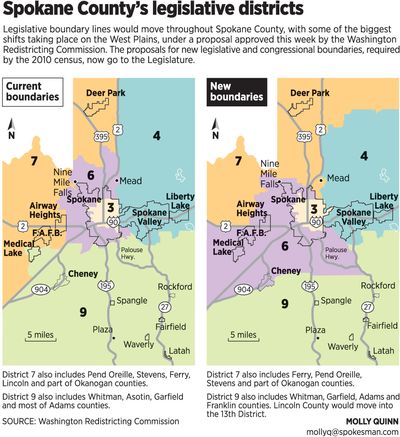Districts undergo shuffle
Legislative boundaries likely to maintain areas’ party leanings

Many residents of the West Plains likely will vote for different legislators this fall, even if they like the ones they have right now.
Medical Lake and Cheney residents would no longer be sharing their legislators with Ritzville and Pullman, and Airway Heights and Fairchild Air Force Base residents won’t share theirs with Colville and Republic. Instead, all would elect legislators with voters on Spokane’s South Hill and the city’s northwest neighborhoods under the new boundaries established by the Washington Redistricting Commission this week.
The commission moved much of the West Plains into the 6th Legislative District as it rearranged boundaries around the state to make up for the increased population recorded in the 2010 census.
With a statutory deadline just hours away Sunday evening, the redistricting commission overcame the biggest sticking point in drawing legislative and congressional boundaries for the next 10 years: Eastern Washington legislative boundaries.
The plan on which they settled keeps the 3rd District, the only one contained within the city of Spokane boundaries, solidly Democratic. The 4th District, which includes the cities of Spokane Valley, Liberty Lake and Millwood, is solidly Republican.
Commissioner Tim Ceis, appointed to the panel by Senate Democrats, said the new boundaries keep the 6th District, which surrounds the 3rd on the north, west and south, as a “swing” district. But that description is suspect on two counts.
First, calling the 6th a swing district – one that might elect candidates of either party on any given year – is a stretch. It went some 70 years without electing a Democrat to the Legislature, before doing so in 2006 and 2008, two big years for Democratic candidates nationally and statewide. None of those Democrats served more than one term, and in 2010, a more Republican year at the polls, the 6th went back to the more historic configuration of three GOP legislators.
Second, the new boundaries seem to make the 6th more Republican than before. The commission’s plan sweeps precincts on the lower South Hill and West Central neighborhoods, which trended Democratic in many elections in the last decade, into the 3rd.
Most precincts the 6th gains on the West Plains have been reliably Republican, a computer analysis of recent votes in major partisan contests shows. The Spokesman-Review compared precinct-by-precinct vote totals for Democratic candidates for president, governor, Congress and close state and county offices in 2008 and 2010.
While it’s true that Cheney, parts of Medical Lake and southern Airway Heights trended Democratic in 2008, mainly on the strength of Barack Obama’s vote totals, Airway Heights and Medical Lake were both solidly Republican in 2010, and Cheney was split. Fairchild Air Force Base voted solidly Republican, as did the suburban and rural precincts surrounding the towns and base.
The panel’s compromise on Eastern Washington boundaries also includes an interesting deviation from what would seem an easy line of demarcation between the 3rd and 6th districts in north Spokane. Most early plans used Francis Avenue as the northern boundary of the 3rd, but the compromise plan pops the boundary up briefly toward Five Mile Prairie, to capture parts of two precincts in northwest Spokane, before returning to Francis.
Vote totals in those precincts trend Republican. They also contain the residence of Democrat Marcus Riccelli, who was considering a run against 6th District Republican Rep. John Ahern this year. The new lines would put Riccelli into the 3rd and unable to run against Ahern unless he moves.
The commission’s plan isn’t final. The Legislature can make minor adjustments to the boundaries with a two-thirds vote of both houses before Feb. 10, but it can’t reject the plan outright.